Our verdict
- Top pick in best running shoes for beginners
- Top pick in best running shoes for high arches
Pros
- Amazing value for money
- Excellent durability from heel to toe
- Breathable upper
- Stable ride
- Comfortable fit
- Great for casual wear too
- Ideal for heel strikers
Cons
- Rigid build
- Needs to lose some weight
- Subpar grip
- Subpar grip
Audience verdict
Comparison
The most similar running shoes compared
+ + Add a shoe | |||||
|---|---|---|---|---|---|
| Audience score | 82 Good! | 79 Good! | 81 Good! | 82 Good! | |
| Price | £70 | £65 | £90 | £50 | |
| Pace | Daily running | Daily running | Daily running | Daily running | |
| Arch support | Neutral | Neutral | Neutral | Neutral | |
| Weight lab Weight brand | 10.4 oz / 295g 10.8 oz / 306g | 9.7 oz / 275g 9.7 oz / 275g | 10.5 oz / 298g 10.8 oz / 305g | 10.4 oz / 295g 10 oz / 284g | |
| Drop lab Drop brand | 8.5 mm 5.0 mm | 7.8 mm 8.0 mm | 8.6 mm 10.0 mm | 9.0 mm 8.0 mm | |
| Strike pattern | HeelMid/forefoot | Mid/forefoot | HeelMid/forefoot | HeelMid/forefoot | |
| Size | True to size | True to size | True to size | Slightly small | |
| Midsole softness | Balanced | Balanced | Balanced | Balanced | |
| Difference in midsole softness in cold | Big | Small | Big | Small | |
| Toebox durability | Decent | Bad | Decent | Decent | |
| Heel padding durability | Good | Good | Decent | Decent | |
| Outsole durability | Good | Decent | Decent | Good | |
| Breathability | Moderate | Moderate | Moderate | Moderate | |
| Width / fit | Medium | Medium | Medium | Wide | |
| Toebox width | Medium | Medium | Narrow | Medium | |
| Stiffness | Moderate | Moderate | Moderate | Moderate | |
| Torsional rigidity | Stiff | Moderate | Stiff | Stiff | |
| Heel counter stiffness | Stiff | Stiff | Stiff | Moderate | |
| Heel lab Heel brand | 33.5 mm 29.0 mm | 31.2 mm 31.0 mm | 33.0 mm 34.0 mm | 33.5 mm | |
| Forefoot lab Forefoot brand | 25.0 mm 24.0 mm | 23.4 mm 23.0 mm | 24.4 mm 24.0 mm | 24.5 mm | |
| Widths available | Normal | NormalWideX-Wide | Normal | NormalWideX-Wide | |
| Orthotic friendly | ✓ | ✓ | ✓ | ✓ | |
| Season | All seasons | All seasons | All seasons | All seasons | |
| Removable insole | ✓ | ✓ | ✓ | ✓ | |
| Ranking | #272 Bottom 26% | #317 Bottom 13% | #293 Bottom 20% | #275 Bottom 25% | |
| Popularity | #177 Top 49% | #88 Top 24% | #108 Top 30% | #249 Bottom 32% |
Who should buy
We pushed the Adidas Questar 3 to its limits and found it quite interesting for:
- Runners looking for a budget-friendly daily trainer with solid durability in the outsole, toebox, and heel areas.
- Heel strikers who need a bit more support than what most entry-level shoes typically offer.
- Anyone on a tight budget who wants one versatile shoe for casual runs, daily wear, and the occasional gym session.
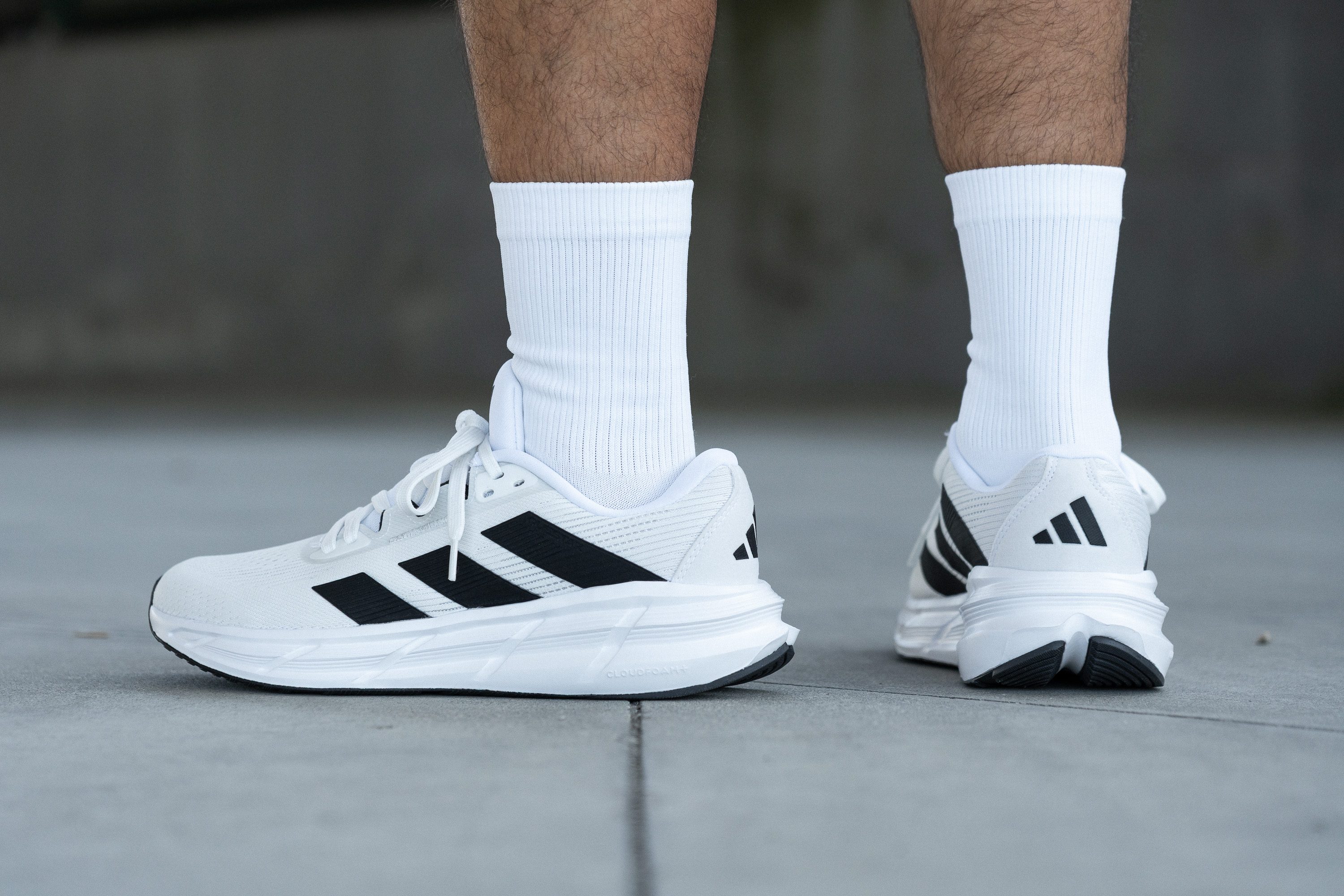
Who should NOT buy
During our lab tests, we discovered that the shoe’s ultra-rigid build and heavy weight made each stride feel a bit forced. For those seeking a more nimble-feeling alternative, we suggest the Nike Interact Run or the ASICS Gel Pulse 15.
We also found the midsole to be overly rigid, lacking the kind of smooth-flowing flexibility many runners appreciate. From our point of view, those who enjoy a comfort-first, flex-friendly transition would be better served by trying the Saucony Ride 18 or the Adidas Runfalcon 5.
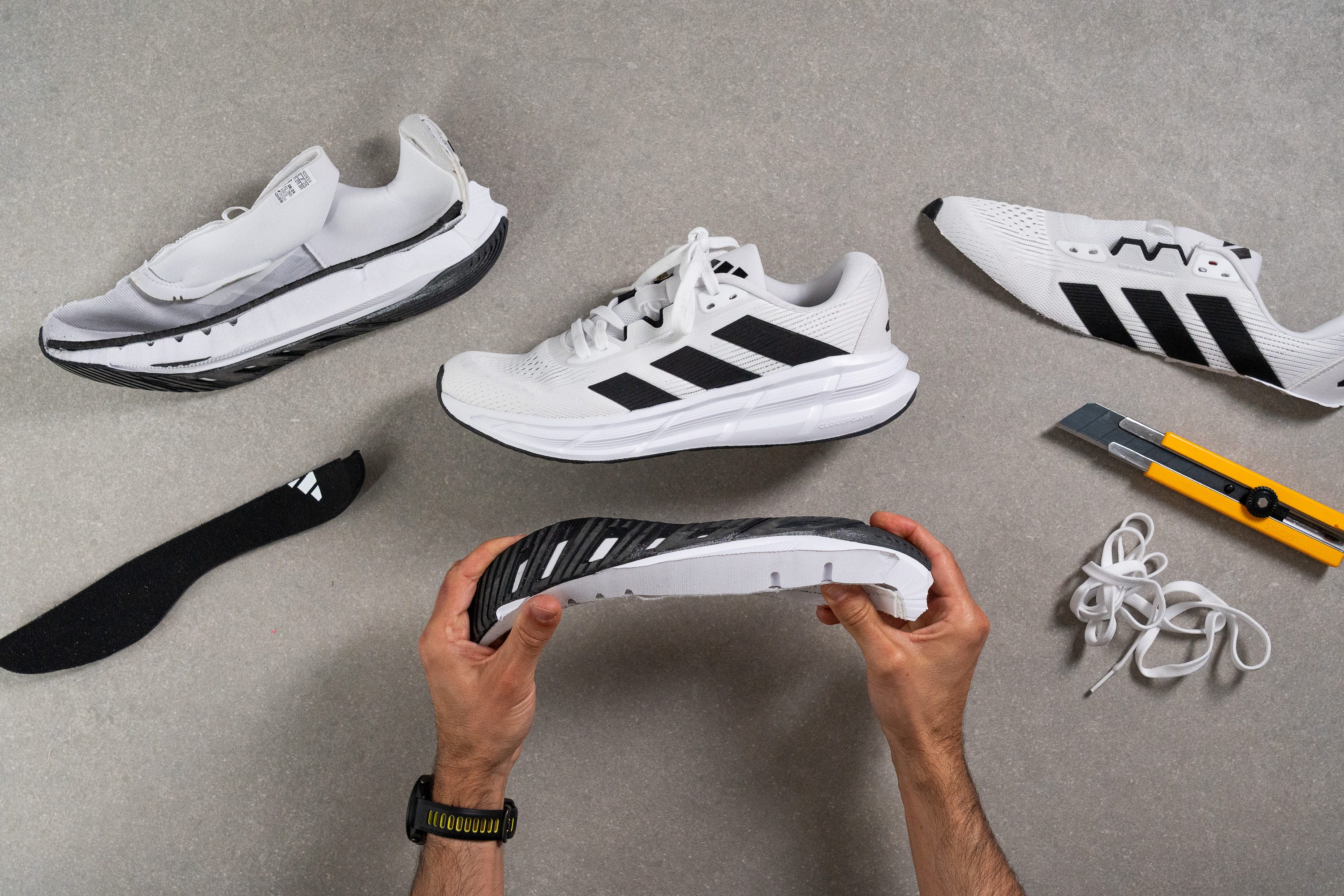
Cushioning
Shock absorption
We pressed the midsole of the Questar 3 with our machine and found just 111 SA in the heel. While that’s expected from budget-friendly daily trainers, keep in mind that it looks noticeably more cushioned than it actually feels underfoot.

| Questar 3 | 111 SA |
| Average | 130 SA |
Energy return
Energy return isn’t groundbreaking, but hitting 54.1% is far from disappointing for a shoe priced well below 100 bucks. In fact, we’re genuinely satisfied with how it performed!
| Questar 3 | 54.1% |
| Average | 58.6% |
Heel stack
Adidas seems to be shifting its strategy by reworking pricey daily trainers into more wallet-friendly versions instead of designing cheap shoes from scratch. These budget adaptations come with slightly lower stack heights and more affordable materials.
For example, the Ultraboost 5 turned into the Ultrarun 5, and the Adistar 3 became the Questar 3. In this case, we measured 33.5 mm in the heel—noticeably less than the 40.7 mm found in its pricier counterpart.
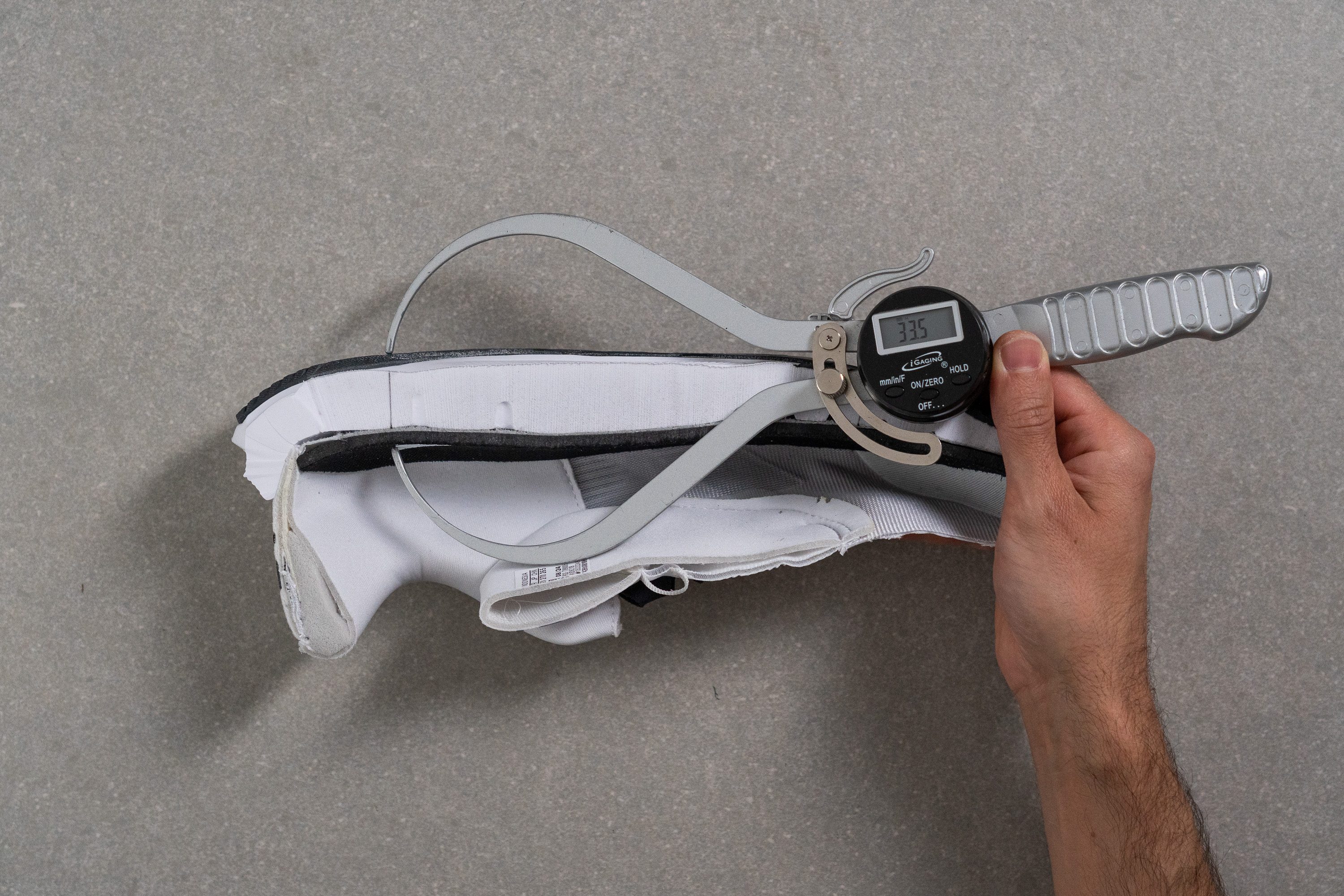
| Questar 3 | 33.5 mm |
| Average | 34.8 mm |
Forefoot stack
We measured the forefoot at 25.0 mm using our digital callipers, and it came right in line with the average. This gives the Questar 3 a versatility edge, making it suitable for everything from relaxed daily use to weekend runs without feeling out of place.
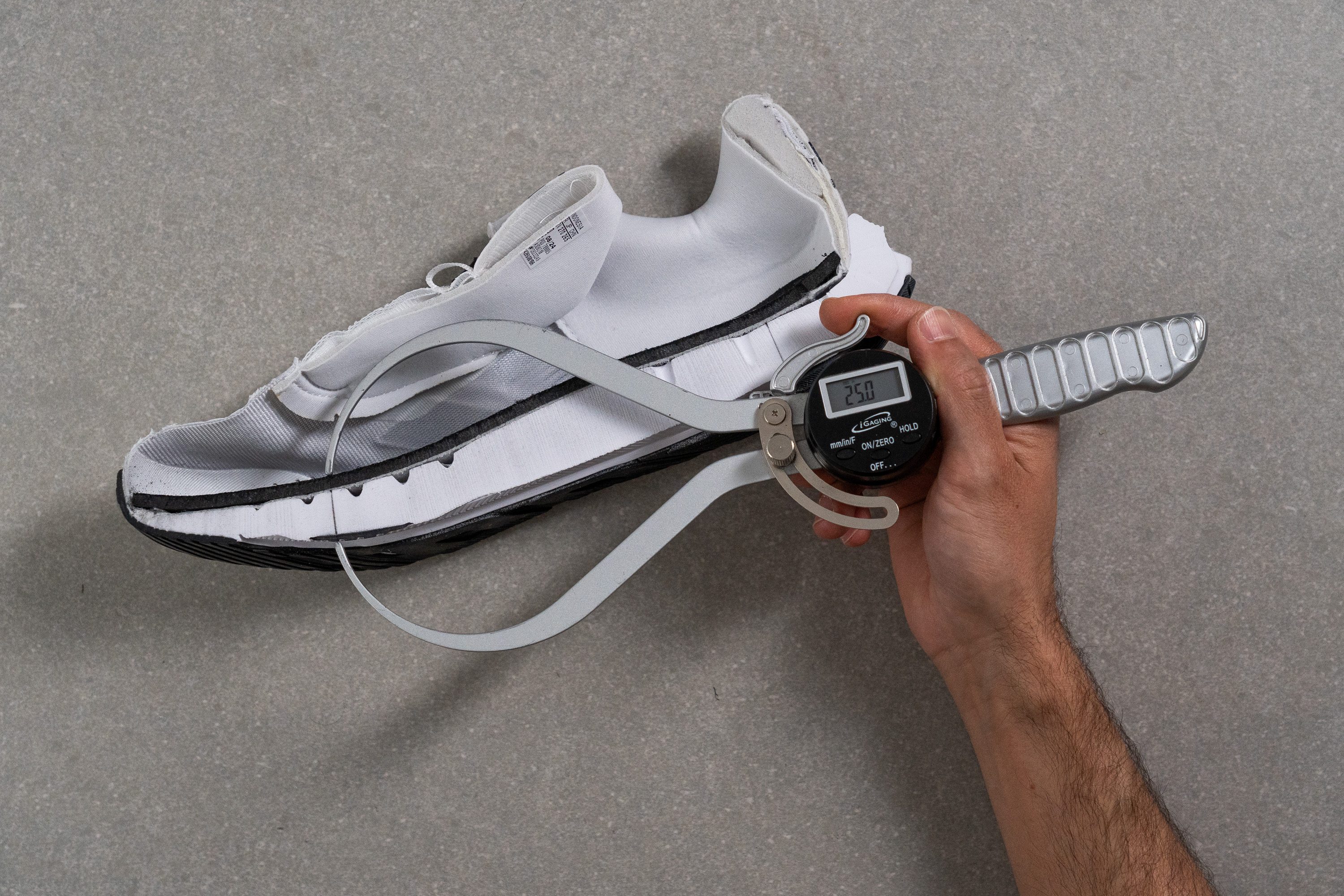
| Questar 3 | 25.0 mm |
| Average | 26.2 mm |
Drop
Adidas claims the Questar 3 has a 5 mm drop, but after multiple checks, we measured it at 8.5 mm. That’s not uncommon for us, and in this case, we believe the difference comes from the midsole, as it features a noticeable midfoot bump that makes this shoe more tailored for midfoot strikers.
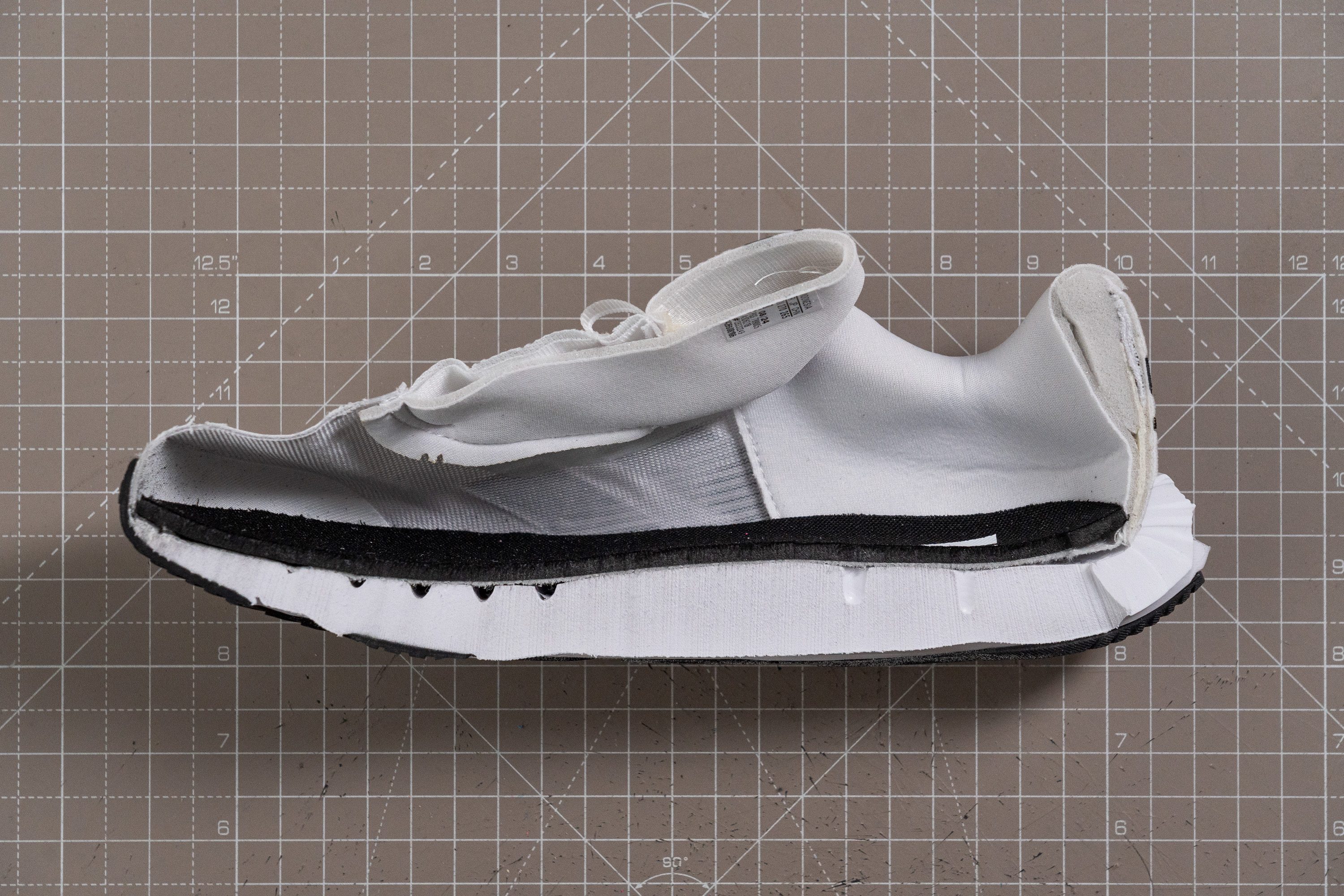
| Questar 3 | 8.5 mm |
| Average | 8.6 mm |
Midsole softness
Another common move from Adidas with their daily trainers is switching to a firmer, lower-cost foam that sacrifices bounce for affordability.
The foam is just a basic EVA compound that offers a flat, dull ride with a moderately firm formulation at 21.3 HA. Then again, given the price point, it's hard to expect anything else.

| Questar 3 | 21.3 HA |
| Average | 20.4 HA |
Rocker
We discovered a low-rocker setup in the Questar 3, perfectly matching its beginner-ready design.
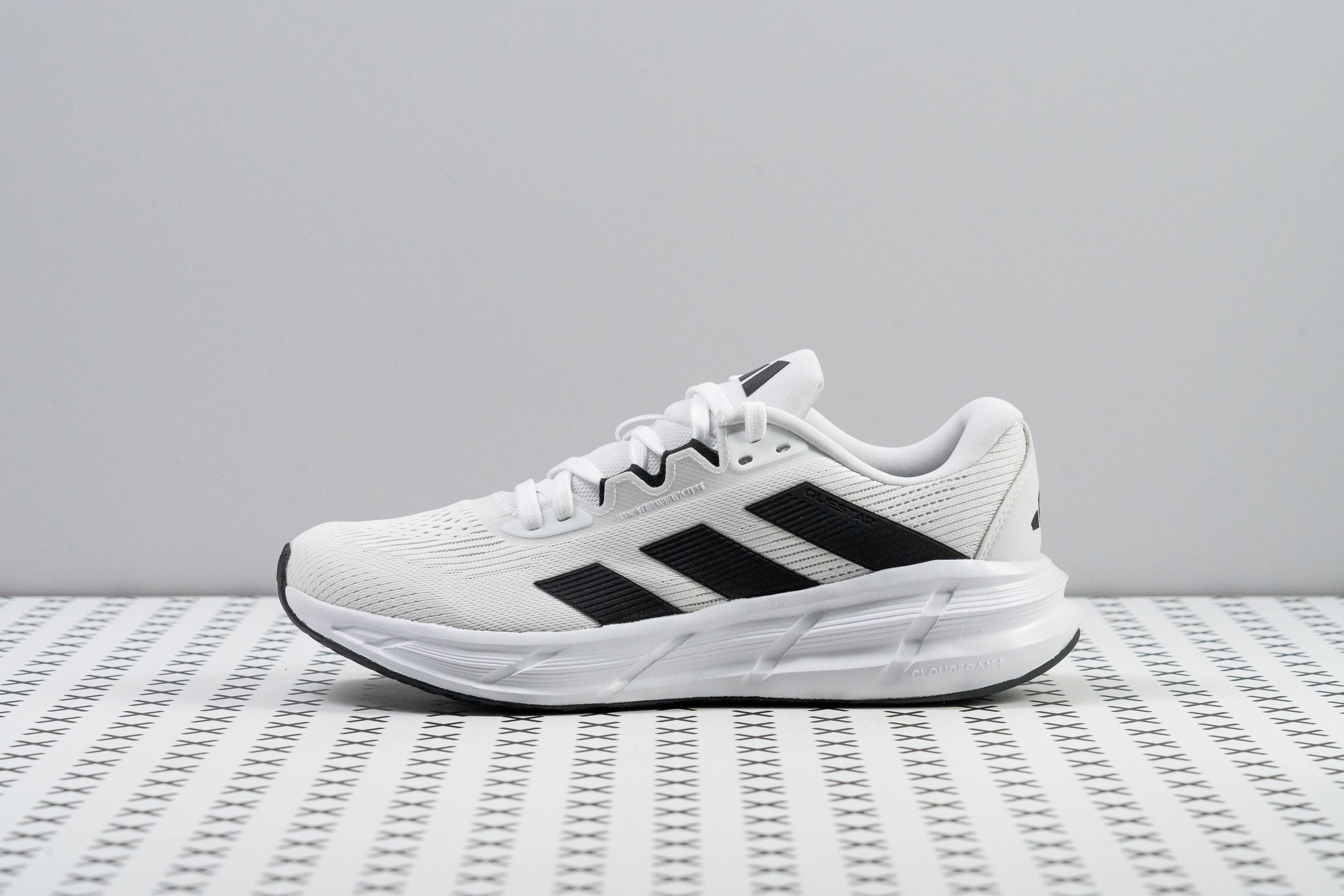
Unlike many recent Adidas models with sharp heel angles, this one keeps things flatter—clearly aimed at people who prefer casual walks or easy jogs over fast-paced running.
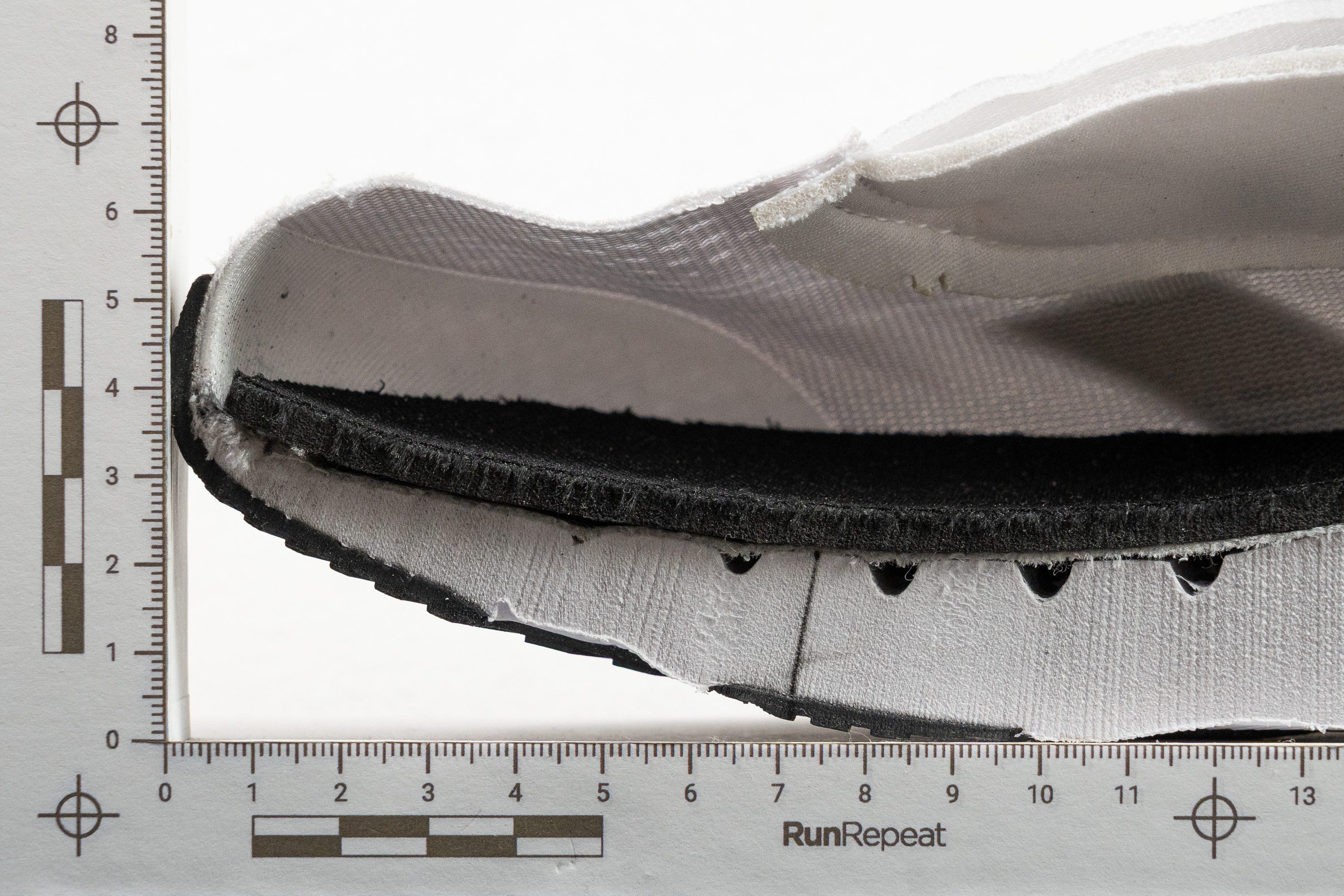
Size and fit
Size
Adidas Questar 3 fits true to size (16 votes).
Width / Fit
Even before measuring, we could tell the fit felt right and the upper didn’t create any weird hotspots.
After crafting our gel mould, we confirmed the forefoot width at 97.4 mm—roomy enough for most feet, though extra-wide ones might feel a bit snug.

| Questar 3 | 97.4 mm |
| Average | 95.1 mm |
Toebox width
The toebox turned out slightly more tapered than average, but the difference is so minor it’s unnoticeable during use. That’s why we think Adidas played it safe with a no-risk design here.

| Questar 3 | 72.8 mm |
| Average | 73.3 mm |
Toebox height
The toebox height earned another green light from us.
We measured 28.0 mm, confirming there’s plenty of vertical space for natural toe movement and relaxed, upward flex.

| Questar 3 | 28.0 mm |
| Average | 27.1 mm |
Traction / Grip
Traction test
The Adistar 3 dropped the Continental rubber used in the previous version and we really disliked that change. As expected, the Questar 3 uses an even lower-grade compound and landed at just 0.33. While it holds up fine on dry ground, we found it borderline slippery on wet asphalt.
| Questar 3 | 0.33 |
| Average | 0.48 |
Outsole design
The Questar 3 features a full-length rubber setup concentrated on both sides of the heel and forefoot. We also discovered a central decoupling groove running from heel to toe, which adds a water-channelling effect.

Flexibility / Stiffness
We got a bit nervous when the Questar 3 hit the maximum score in our torsional rigidity test, but thankfully, that stiffness didn’t carry over to the longitudinal side. We measured 14.2N, which is a fair result for a daily trainer and makes it a solid pick for walking and jogging too.

| Questar 3 | 14.2N |
| Average | 15.3N |
Weight
Weight isn’t exactly where the Questar 3 shines. But considering the Adistar 3 already tipped the scales at 9.7 oz or 274g, it made sense that Adidas wasn’t going to deliver a lighter version with the Questar 3, which is the low-end variant.
That’s why 10.4 oz or 295g feels acceptable here, even if it lands on the heavier side.

| Questar 3 | 10.4 oz (295g) |
| Average | 9.3 oz (264g) |
Breathability
We were curious to test the upper of the Questar 3 after spotting plenty of ventilation holes that looked promising—but with thick materials, results are never certain until we run the smoke test.
Fortunately, we got a 4/5, which is our favourite score for daily trainers. It means the shoe keeps your feet warm enough in cold weather, while still offering strong airflow during summer—perfect for runners using one pair year-round.
Most of the ventilation comes through the toebox. The rest of the upper is dense and tightly built, so air won’t escape from those areas, which is something to keep in mind.
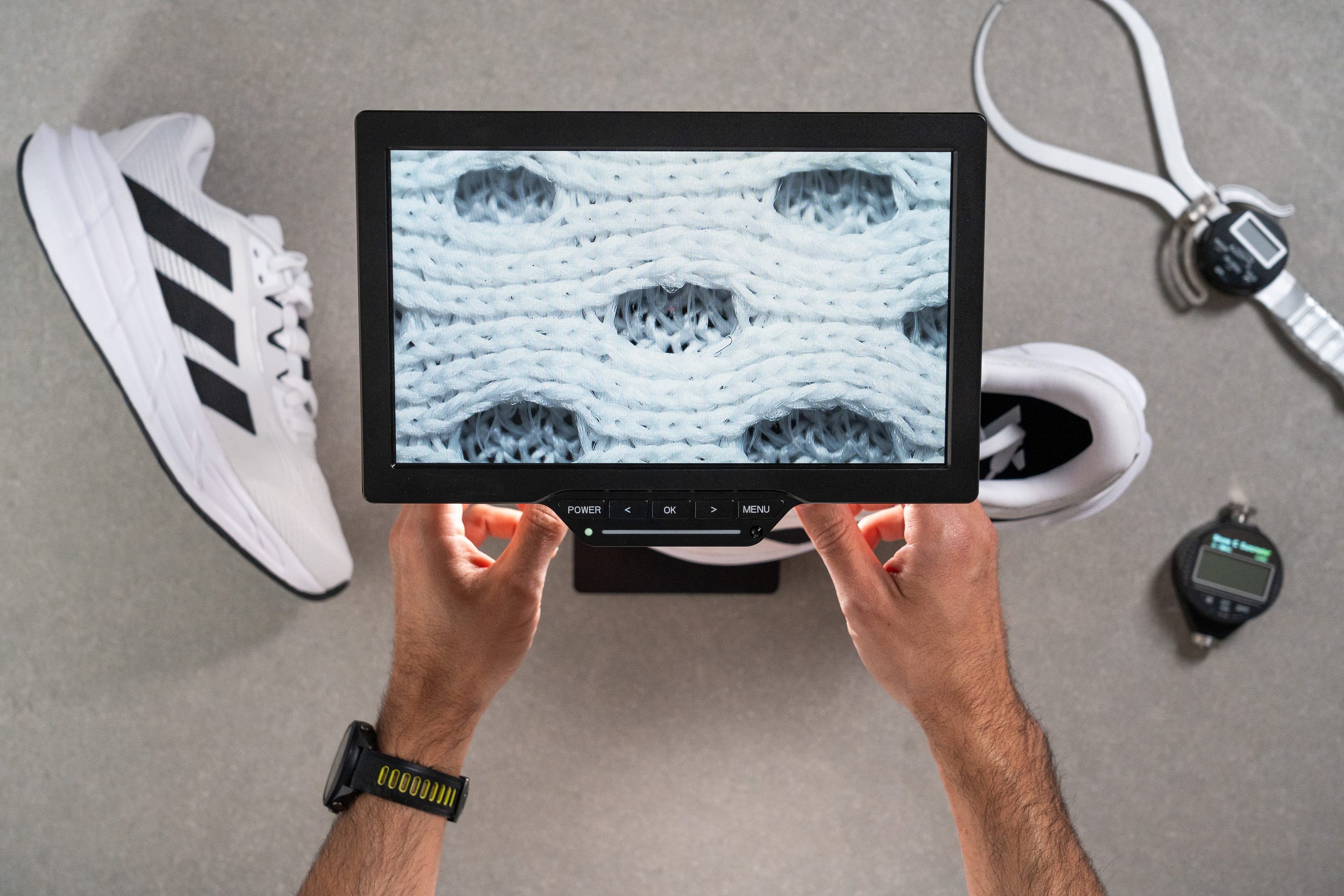
Under the microscope, we identified a standard engineered mesh that we've seen in many shoes. That’s not a bad thing though, as it balances durability and breathability well.
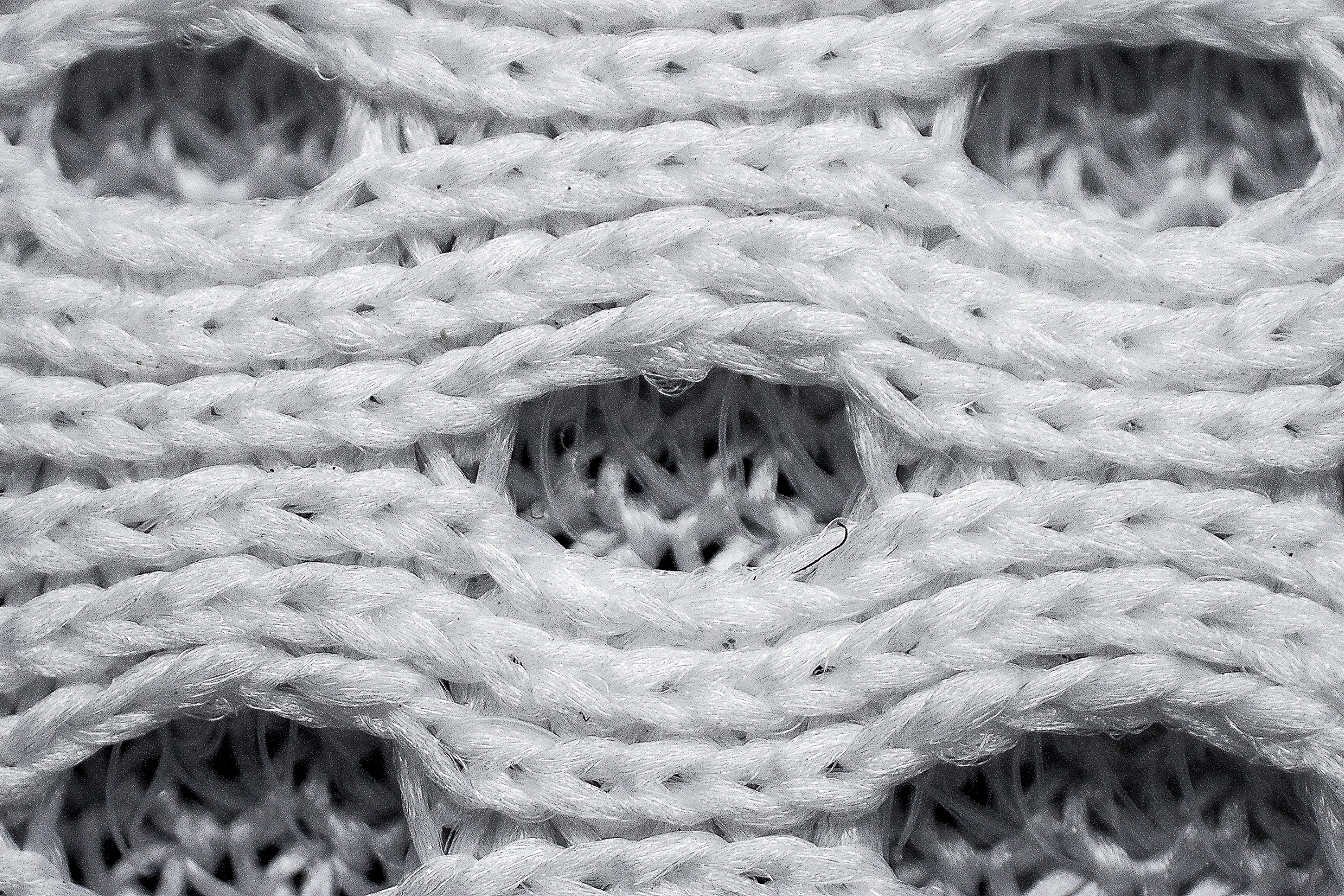
There's also generous comfort throughout and an oversized heel padding that feels extra-cosy for casual wear or long, easy sessions.
| Questar 3 | 4 |
| Average | 3.7 |
Stability
Lateral stability test
The Questar 3 feels remarkably stable underfoot. Although it's labelled as a neutral daily trainer, we believe runners with mild stability needs can confidently use it for all kinds of runs. Its raised midsole sidewalls, broad heel, rigid platform, and central guidance line work together to keep each stride well-centred.
Torsional rigidity
We measured a maximum 5/5 score, which caught us off guard in a shoe with this kind of stack height.
While this ultra-stiff setup boosts stability, it also sacrifices everyday comfort and that easygoing feel that many runners look for in daily trainers. It even outscored the Adistar 3 in rigidity, likely due to its denser midsole foam.
| Questar 3 | 5 |
| Average | 3.5 |
Heel counter stiffness
We found the heel counter to be fairly stiff, scoring a solid 4/5 in our test. However, the generous, comfort-boosting padding that Adidas added does a great job of offsetting any harsh or unforgiving sensation.
| Questar 3 | 4 |
| Average | 2.9 |
Midsole width - forefoot
The Questar 3 doesn’t come across as a compact shoe, but it’s far from bulky. With a forefoot midsole width of 114.3 mm, it lands in a sweet spot that feels balanced and grounded without being oversized.
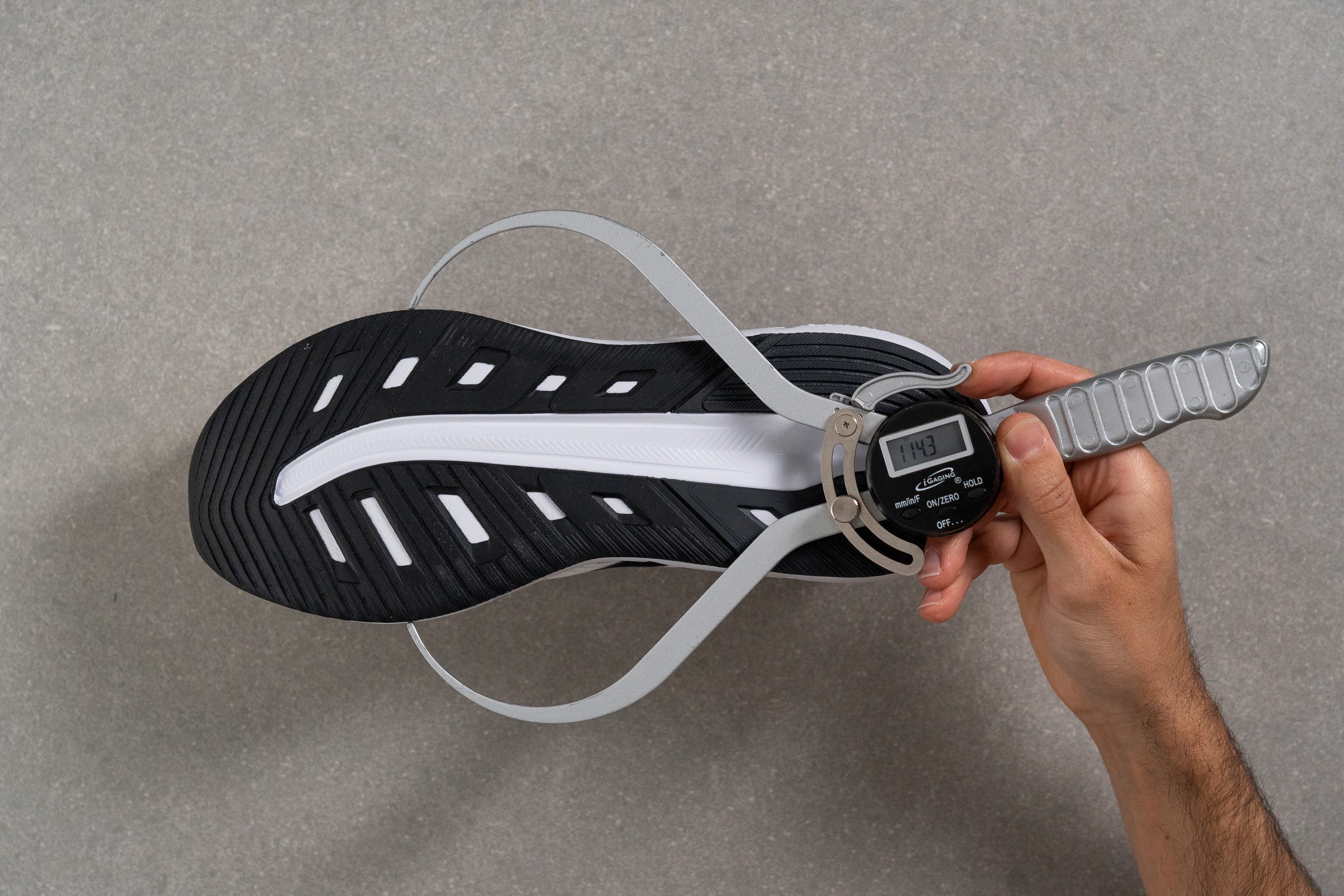
| Questar 3 | 114.3 mm |
| Average | 114.3 mm |
Midsole width - heel
The heel measures a wider-than-average 95.7 mm, which didn’t catch us off guard. At this price point, the shoe clearly targets heel strikers, offering extra width that enhances stability.
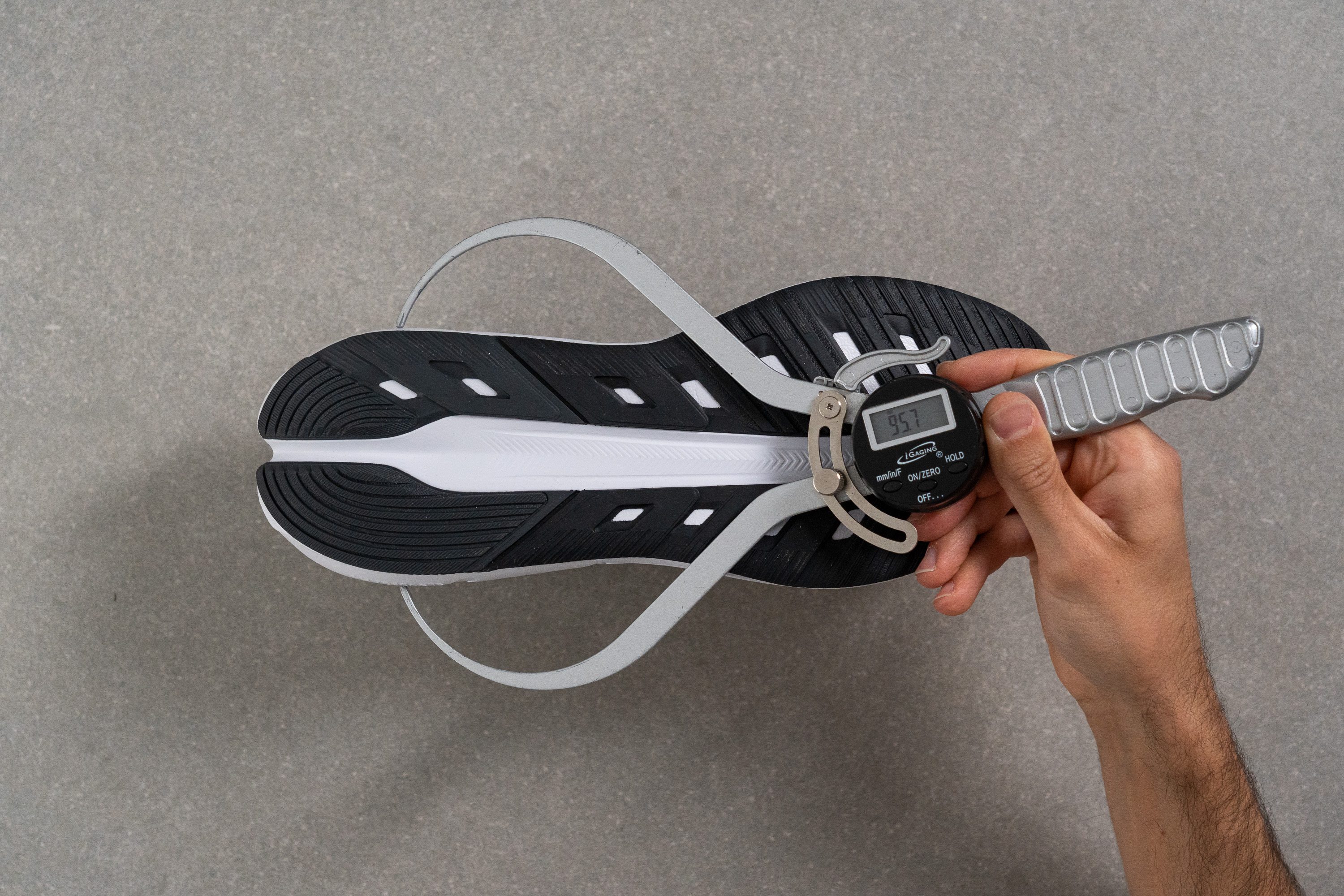
| Questar 3 | 95.7 mm |
| Average | 90.7 mm |
Durability
Toebox durability
The thick engineered mesh on the Questar 3 held up well in our Dremel test—earning a solid 3/5 score, which isn’t easy for a budget-friendly shoe. Let’s now take a look at the heel.
| Questar 3 | 3 |
| Average | 2.6 |
Heel padding durability
The heel padding also performed well, beating the average running shoe with a 4/5 score—and keep in mind, this shoe sits at the lower end of the price range!
| Questar 3 | 4 |
| Average | 3.4 |
Outsole durability
We wrapped up the trio of Dremel tests with the outsole, and once again, we were satisfied—just 0.8 mm of wear. Honestly, only a small number of shoes out there manage to beat the average across all our durability evaluations.
| Questar 3 | 0.8 mm |
| Average | 1.1 mm |
Outsole thickness
No surprises here from Adidas. With 3.5 mm of rubber, they played it safe to make sure the outsole won’t wear down too soon—there’s more than enough thickness to handle daily use.
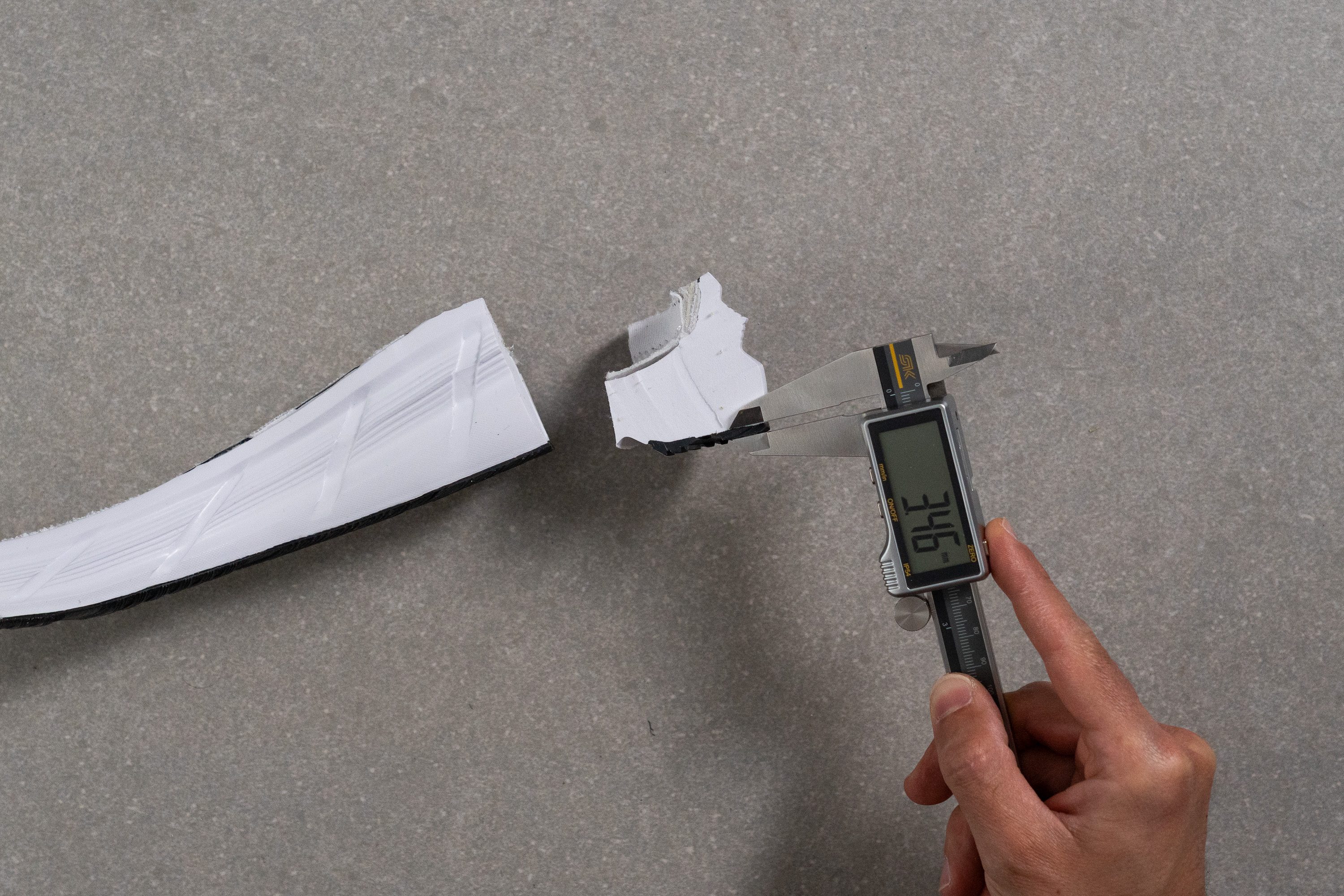
| Questar 3 | 3.5 mm |
| Average | 3.2 mm |
Misc
Insole thickness
The insole adds 4.1 mm of cushioning to the overall stack height of the shoe.
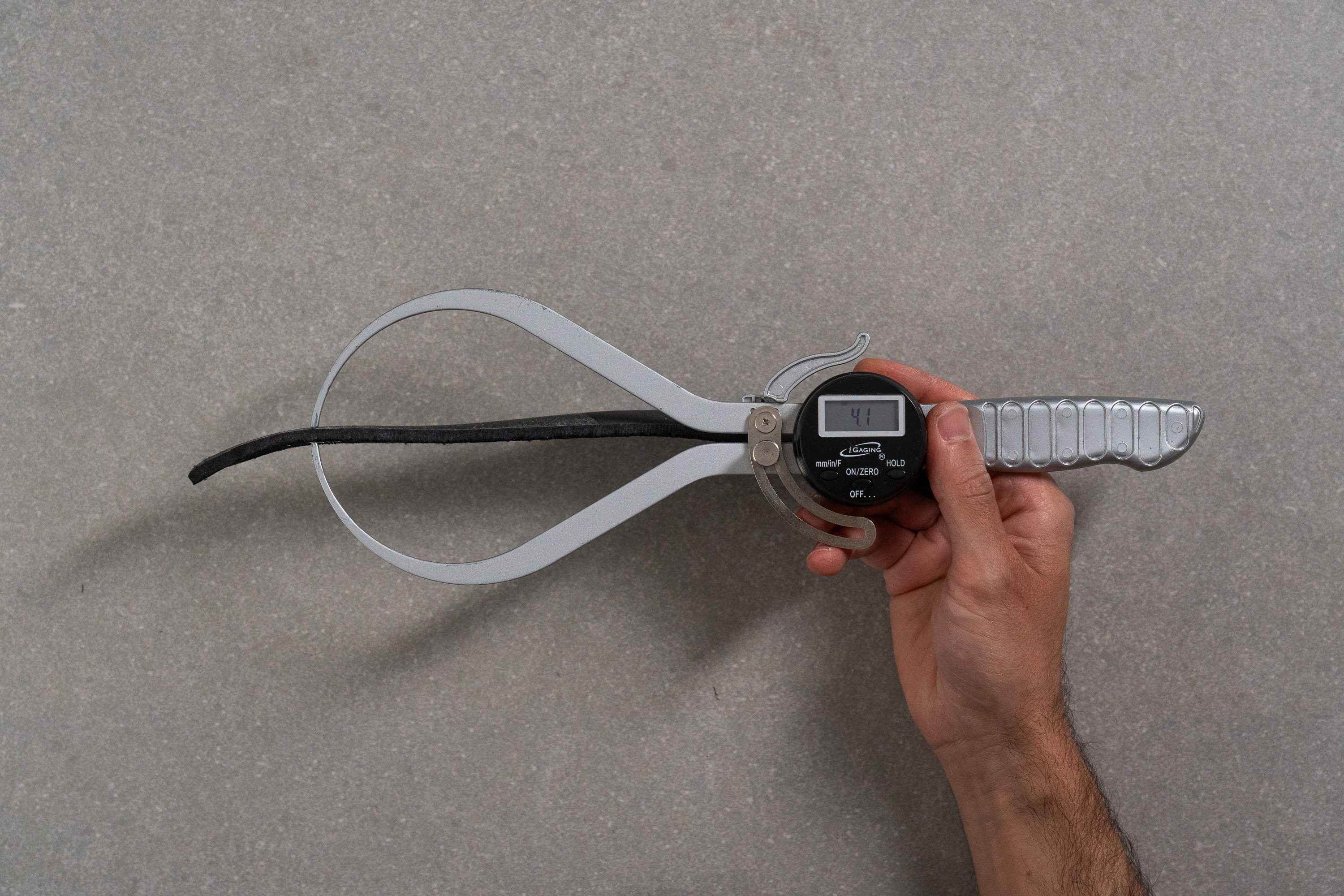
| Questar 3 | 4.1 mm |
| Average | 4.5 mm |
Removable insole
The Cloudfoam Plus insole is removable, so you can swap it with your favourite from another shoe.
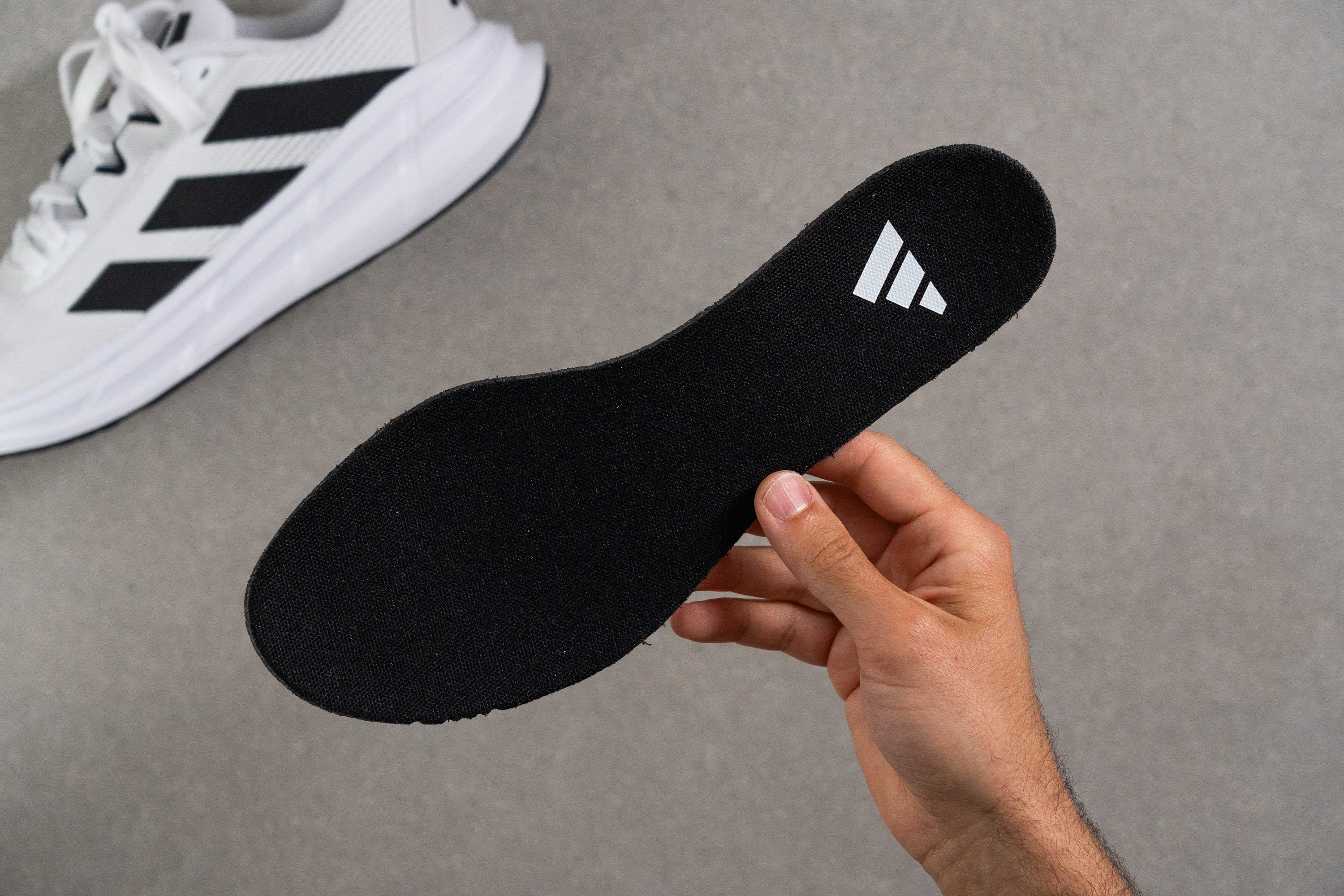
| Questar 3 | Yes |
Midsole softness in cold (%)
After placing the Questar 3 in the freezer for 20 minutes, we measured a staggering 41% increase in firmness, confirming this chill-sensitive behaviour of EVA foams firsthand.
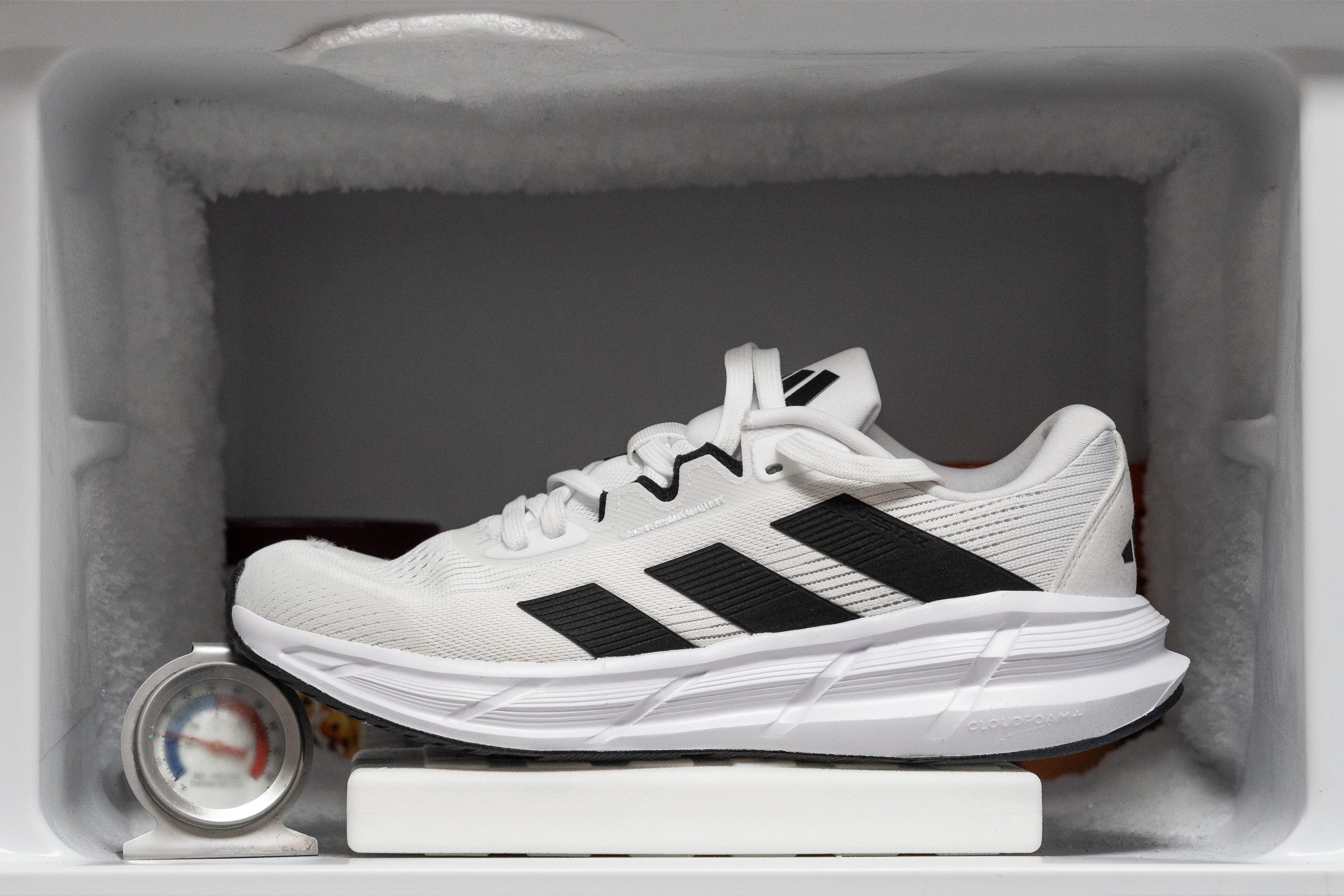
| Questar 3 | 41% |
| Average | 24% |
Reflective elements
One of the small cost-cutting choices Adidas made to keep the shoe affordable was skipping reflective elements.
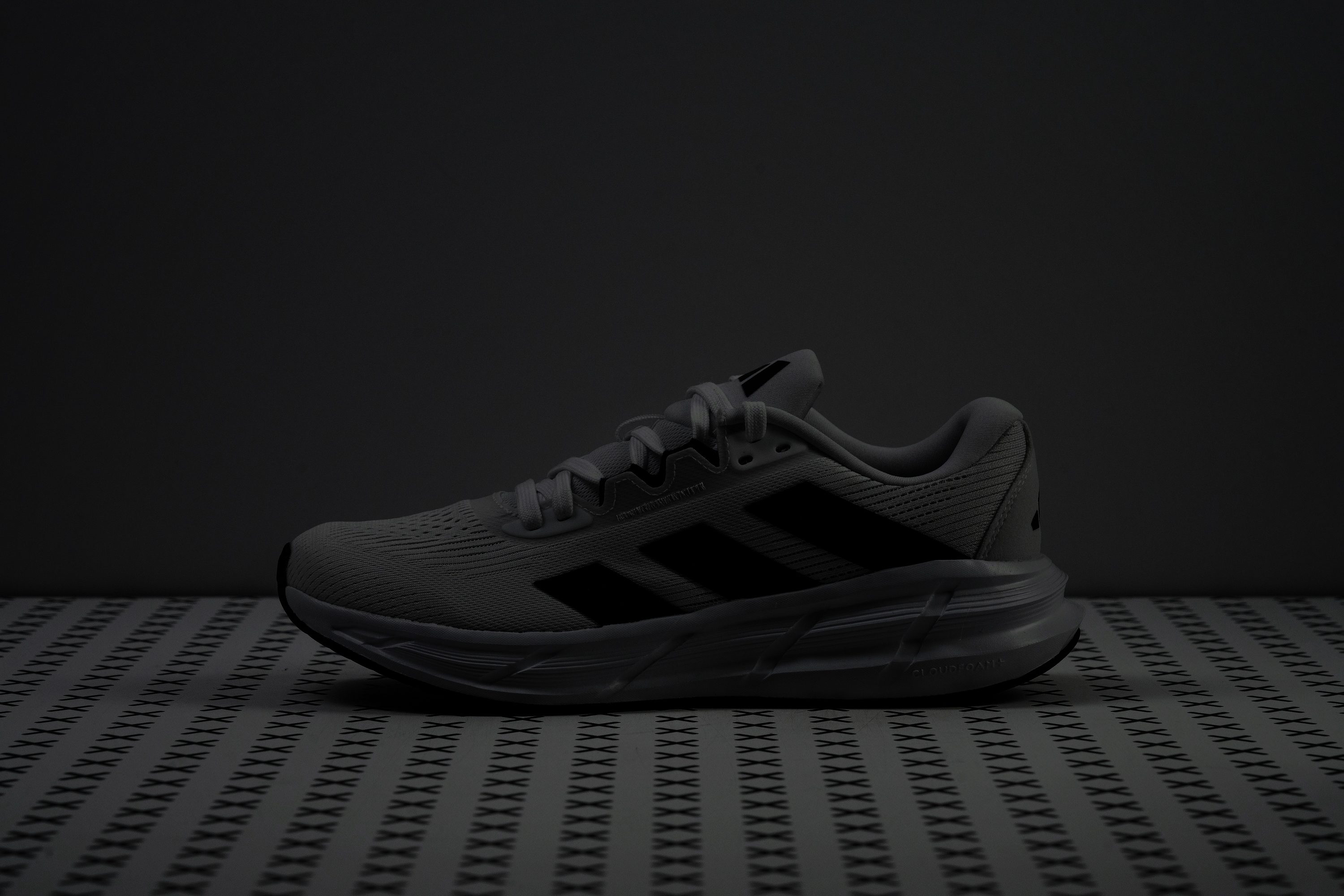
| Questar 3 | No |
Tongue padding
We discovered that the Adidas Questar 3 comes with a rare triple-eyelet layout at the top of the lacing system—offering extra adjustment options for a snug, ankle-focused lockdown and creative lacing tricks.

We also tested its slim 4.7 mm tongue and found it surprisingly minimal for a budget shoe, as it skips the thick padding often seen in this price range.
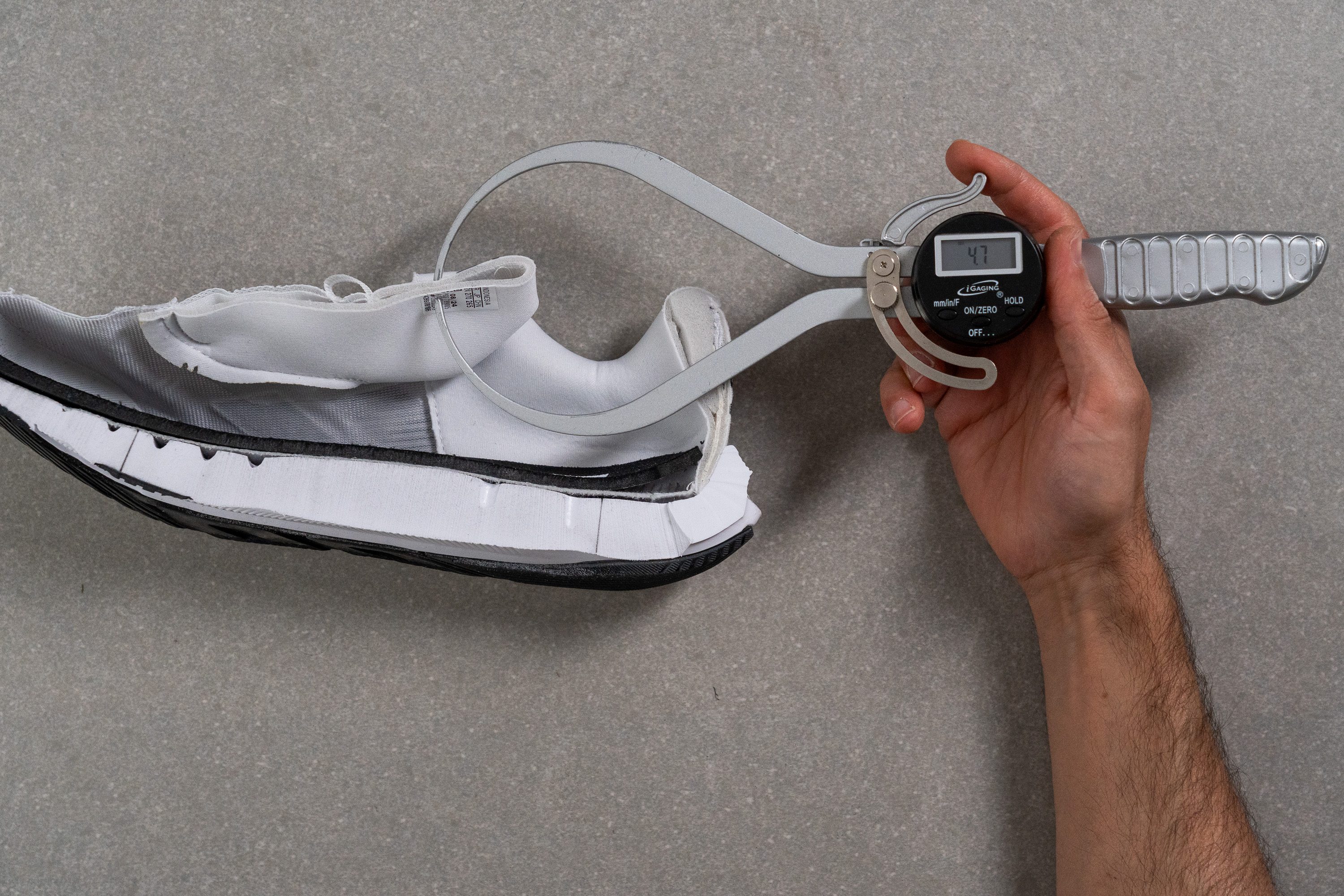
| Questar 3 | 4.7 mm |
| Average | 5.8 mm |
Tongue: gusset type
The tongue isn’t gusseted, which isn’t great for fit—but it’s what we usually see in most shoes under 100 bucks, so we can't complain. Still, having it would’ve been a cool bonus.
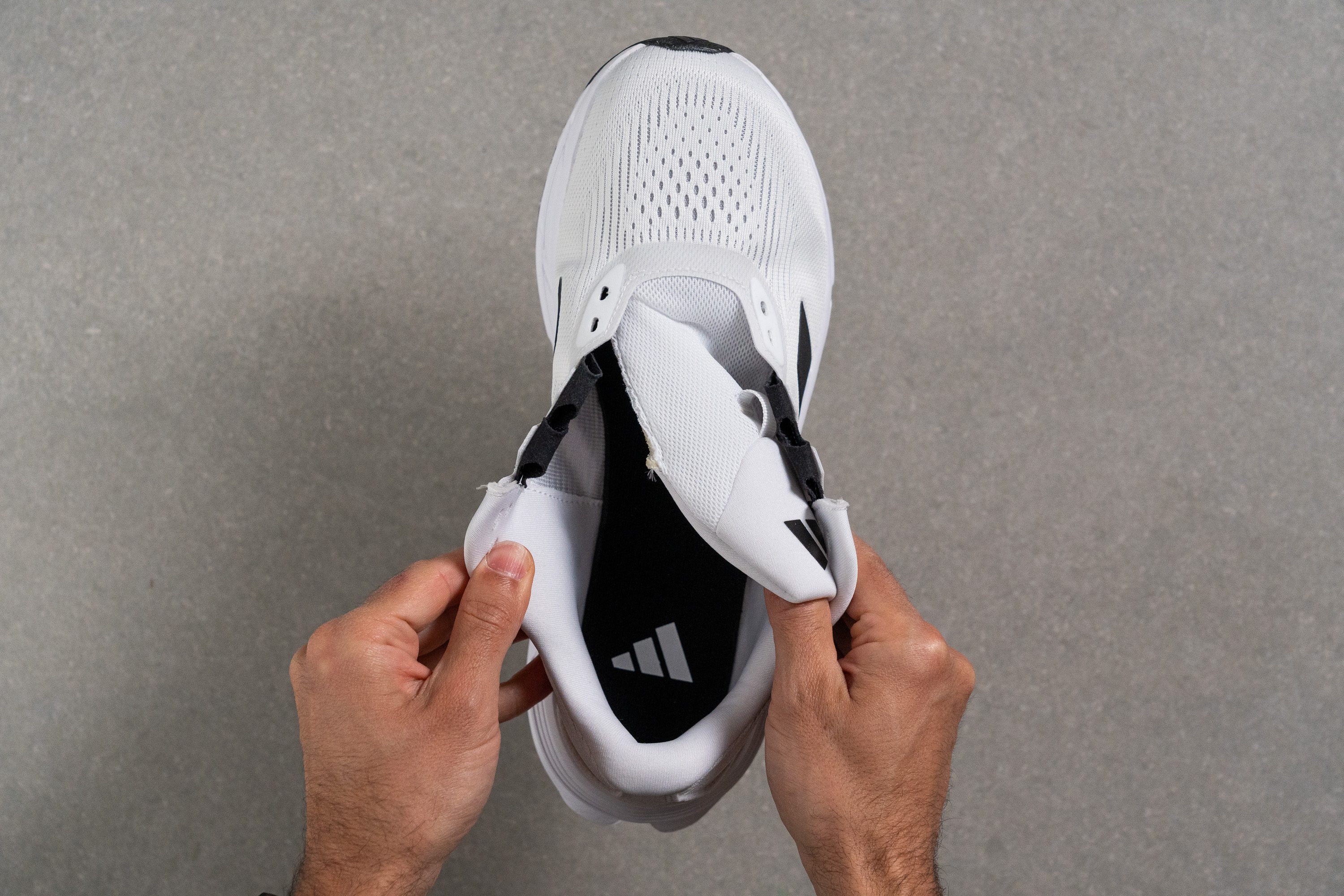
| Questar 3 | None |
Price
The Ultrarun 5 comes in at a low price, far lower than most daily trainers and significantly cheaper than the Adistar. This cost-saving move clearly involves a few trade-offs in materials and energy return, but it's a fantastic price for every runner.
| Questar 3 | $75 |
Heel tab
The heel skips the finger-loop pull tab. Instead, Adidas added yet another logo to remind you who made the three stripes.
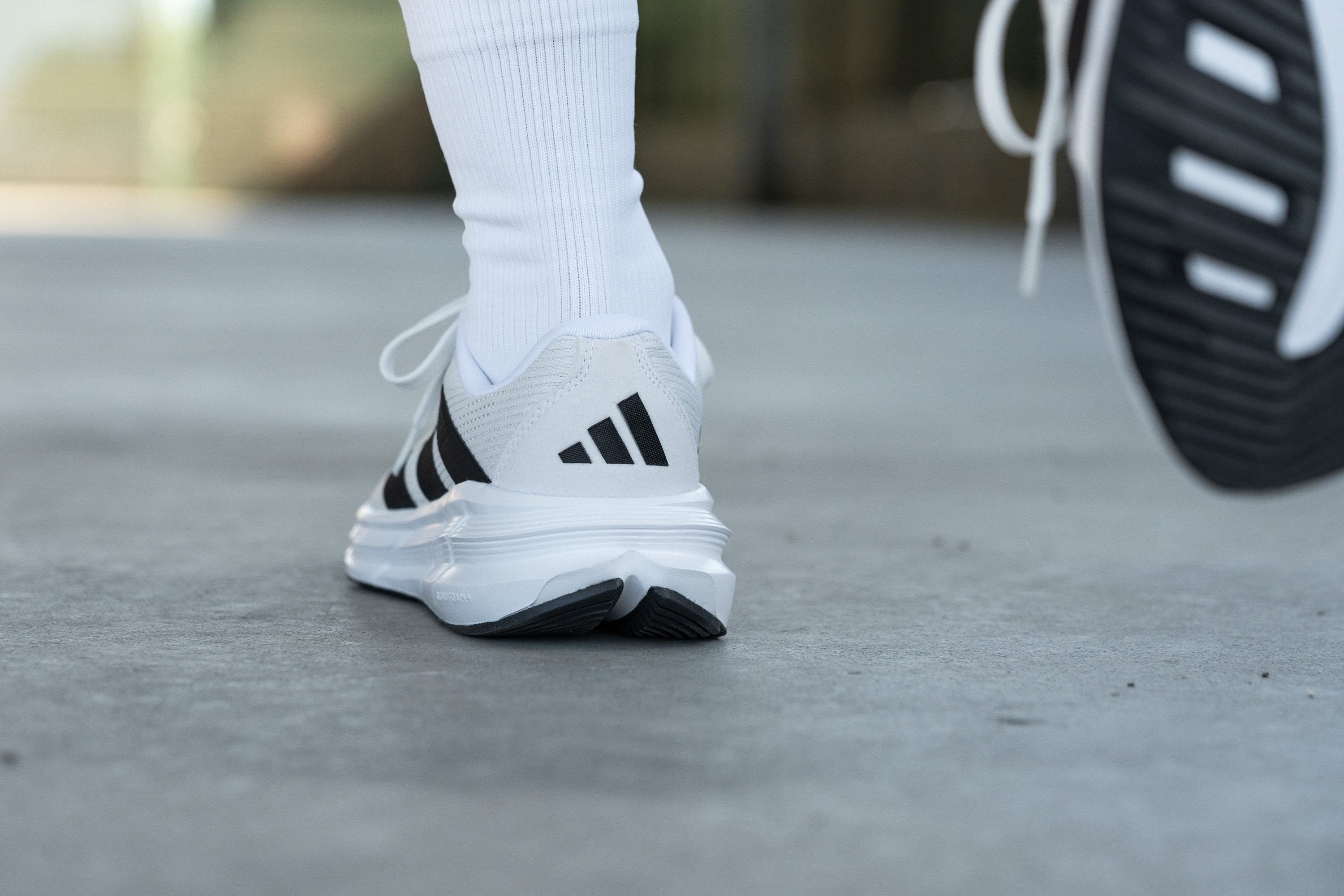
| Questar 3 | None |

















































